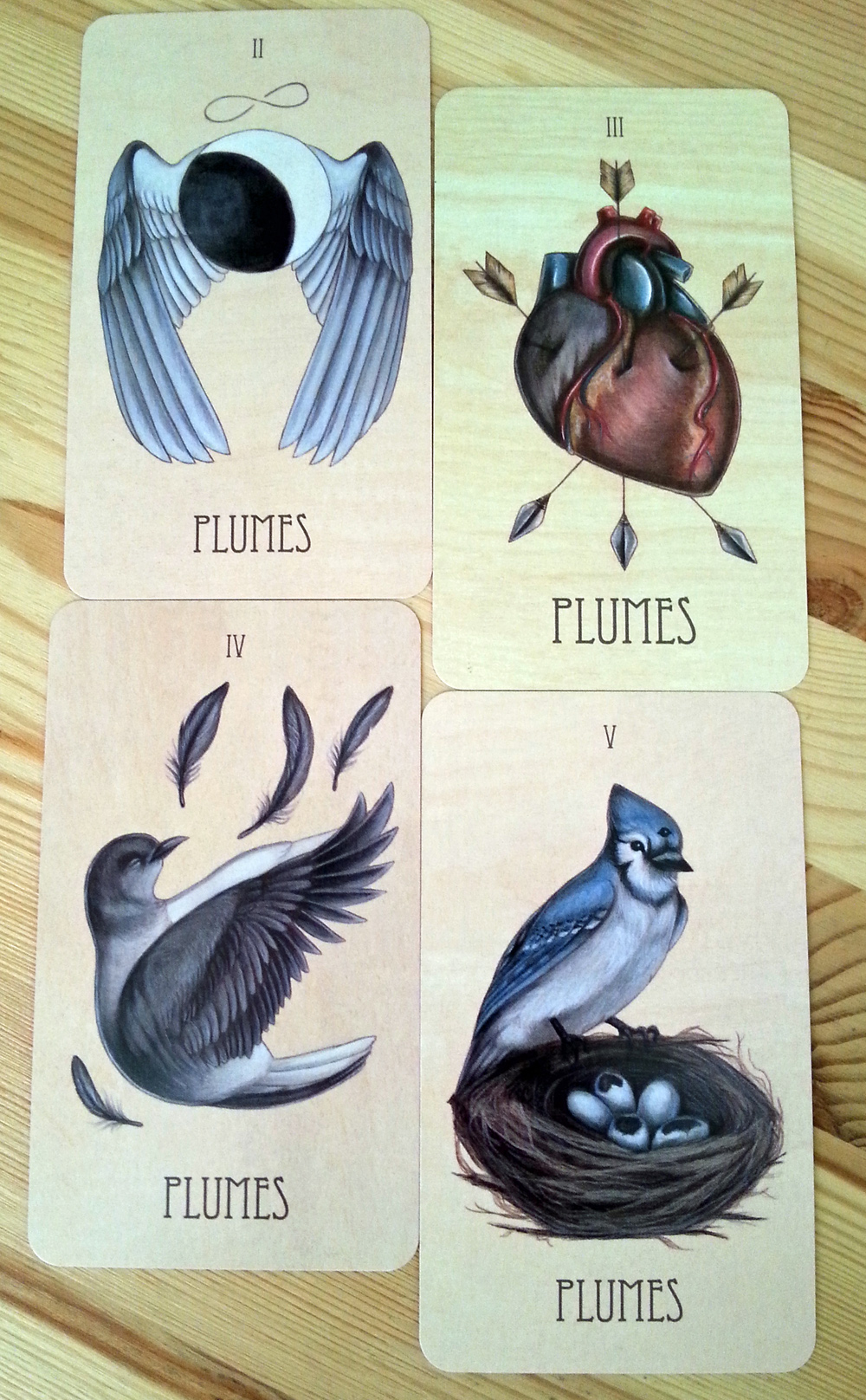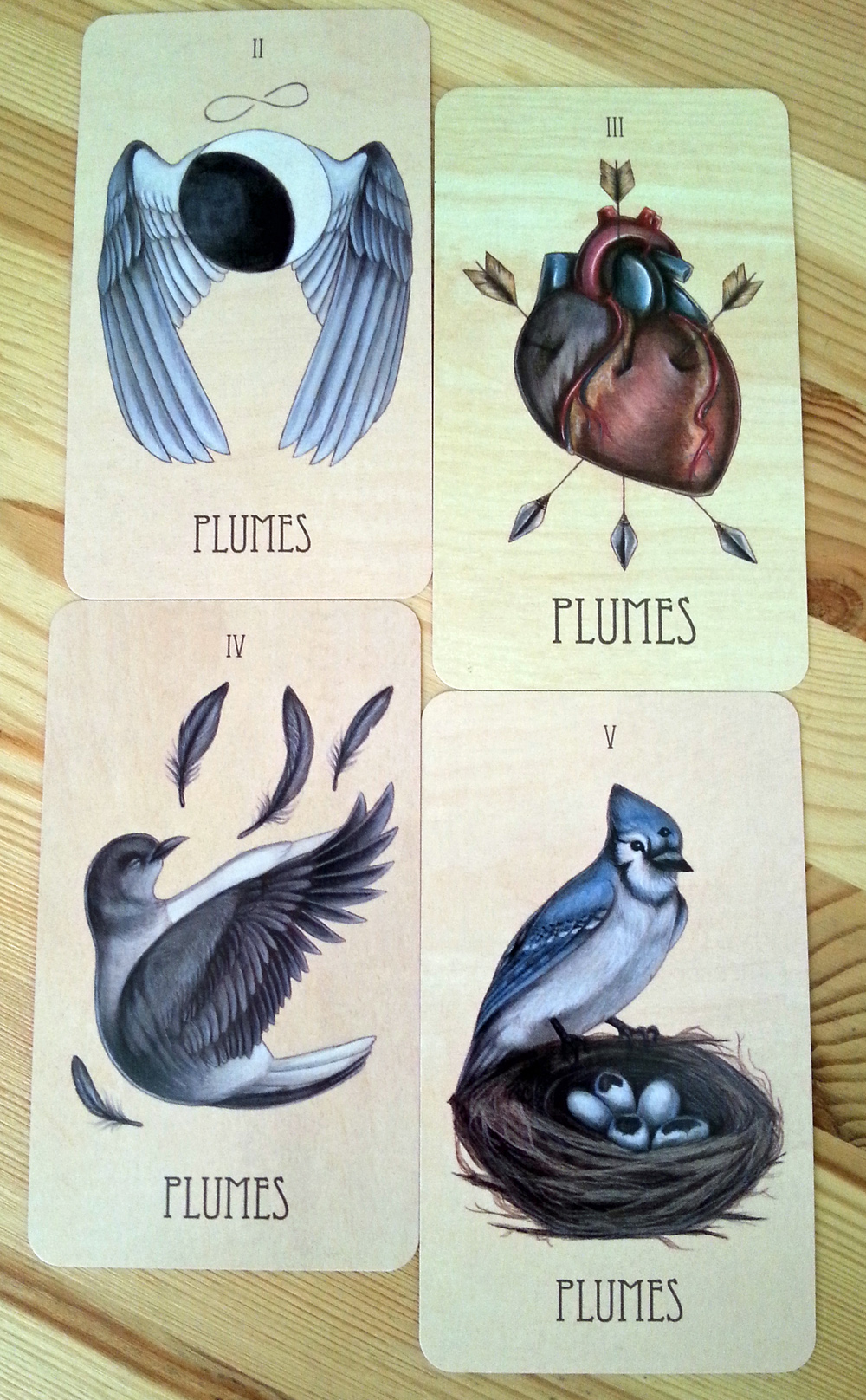This is part of an ongoing series in which I write about my interpretations of the cards in A.L. Swartz’s Wooden Tarot. You can find the other posts here.
Two of Plumes
Two partially folded, white-gray wings appear on either side of a waxing crescent moon. Above it floats a lemniscate.
As with the other twos, the lemniscate indicates balance and change. In a bird’s wings, balance is extremely important since a bird cannot fly with an injured or deformed wing. Without perfect symmetry or equal participation, flight can’t take place.
I see this card’s meaning as being closer to that of the Two of Swords in the Thoth deck–“Peace”–than in the Waite-Smith deck. In the latter, a woman sits holding two crossed swords across her chest, suggesting that the swords work at cross-purposes. Hence the common interpretation of this card as being about needing to make a decision–either this sword or that sword must be chosen, but not both. In the Wooden Tarot Two of Plumes, the wings work together, making for a very different meaning.
The question this card asks is: How do ideas or belief systems hold each other in balance? For instance, in a legal case, one wing cold represent the law, while the other could represent what is fair from a human-centered perspective. A common image in Buddhist thought is the wings of wisdom and compassion. Wisdom without compassion is cold and heartless, and will ultimately not benefit anyone. Compassion without wisdom is misguided and perhaps even harmful. Just like a bird needs both wings to fly, we need wisdom and compassion to act skillfully.
The Two of Plumes, then, is not so much about making a one-or-the-other decision, but about figuring out how to balance ideas and paradigms. And if the lemniscate didn’t clue you in, the waxing crescent moon shows that there is no one right answer for all time. Things are in constant change, and so the kinds of knowledge and practices are appropriate to bring to any situation will always be changing as well.
Keys: balance; fairness; tempering extreme ideas; balance of head and heart; making a decision or undertaking a project with a balanced perspective; neither extreme optimism nor extreme pessimism; sense and sensibility
Reversed: continually favoring one set of ideas or beliefs over another; dogma; unwillingness to meet halfway on an idea; assuming that the same idea or procedure applies equally in all situations; losing perspective
Three of Plumes
Three arrows pierce a heart.
This is one of the few places in the deck where Swartz stays close to the Waite-Smith image. It’s one of the most universally recognizable and interpret-able image in tarot, and its associations with pain and grief are easy to see.
It’s worth noting a couple of things about this card, though. The first is the thickness of Swartz’s arrows. All throughout this suit, arrows are thin–basically drawn as a single line, rather than cylinder. To me, this emphasizes the airy insubstantiality of thought and the truth that thoughts and words can hurt so deeply even though they are not “real” in a physical sense.
Second–look at the arrowheads on these arrows. Make no mistake–these are for hunting, not archery. Whether true or not, it feels like someone has taken direct aim at us and is trying to bring us down.
But to me, the most important thing about this card is the anatomical detail of the heart, which is very different from the stylized heart in the Waite-Smith or Sola Busca (the deck whose 3 of Swords the Waite-Smith image is based.) While, miraculously, no blood drips from this heart, we see it in great detail–muscle, ventricle, artery, vein. This could mean that the pain is raw–almost too much to look at–or that we are prone to over analyzing it and thinking about it in detail.
This reminds me of another classic Buddhist teaching: the two arrows. We get struck with the first arrow, which causes a great amount of pain–we get fired, snubbed by a friend, cheated on, etc. That pain is an inevitable part of life. But then we hit ourselves with a second arrow in the same place (which of course hurts much worse) because of the way that we react to the first: lashing out in anger, drowning in self-hatred, and obsessing about what has happened. So in this card, the heart’s detail has two dimensions: the pain itself, and the additional pain caused by obsessively thinking about and examining it. It asks: where is the line between necessary grief and refusing to let go and move on?
Keys: pain; grief; loss; betrayal;
Reversed: obsessing or over thinking something painful that has happened; feeling stuck and unable to move on (Note: depending on the context of the reading, this card reversed could also mean a lessening or ending of pain)
Four of Plumes
A small gray bird lies with its wings stretched in front of it, eyes closed. Four of its feathers are scattered around it.
This is the first of several birds we will encounter in this suit. While Swartz can be extremely precise as to species, this one strikes me as being a fairly generic bird. It may be worth noting that its wings look similar to those in the Two of Plumes.
I usually see the Four of Swords as a fairly positive card, but this card is a little darker. This is not a natural position for a bird to be in. If I saw one like this outside, my first assumption would be that it had died a violent death (even when they die from hitting windows their wings usually fold back up.) At best, it has been knocked unconscious. I’m just going to take it on faith that this bird is alive, but in any case it’s been through some sort of trauma. Perhaps it can pull itself back together, but those feathers are gone for good.
[Note: I know that some people might have a gentler interpretation of this card, since it kind of looks like the bird is cuddled up sleeping. But once a birder, always a birder, you know?]
Keys: slow healing; after-effects of trauma, recent or far in the past; moving slowly in grief; licking your wounds; cutting your losses
Reversed: readiness to move on; completion of healing
Five of Plumes
A three-eyed Blue Jay is perched on the edge of a nest. Three of the five eggs in the nest have been broken.
In this card, Swartz’s precise attention to bird species is on display. For those who do not live in eastern North America, let me give you the low-down on the Blue Jay. They are beautiful, loud, aggressive birds. They will not hesitate to terrorize the neighborhood cat that comes too close to their nests. They will send up loud alarm calls at the slightest hint of a predator. They are absolutely gorgeous, but have a mixed reputation at feeders due to their habit of chasing smaller birds away.
Blue jays are also omnivorous and have been known to eat eggs and nestlings, which makes them the perfect species for this card. The Blue Jay perched on this nest wears an inscrutable expression. It could be just finishing its meal of three eggs, or it could be a mother returning to the nest to find all but two of her eggs eaten. All is not lost–this is not the lowest point in the suit–but damage has been done. This card carries the same ambiguity as the Waite-Smith Five of Swords, which could be about the haughty aggressor or those who walk away from him in battle. The third eye on this Blue Jay does suggest, however, that whether aggressor or victim, there will be an opportunity to gain spiritual insight from this encounter.
Keys: aggression; theft; domination; trickery; OR being on the receiving end of aggression or some sort of fraud–a good deal of damage has been done, but it’s best to learn your lesson for next time and be thankful for what you still have
Reversed: rectifying an injustice or striking back at an aggressor; a battle in which there may be no clearly right or just side;


Leave a Reply